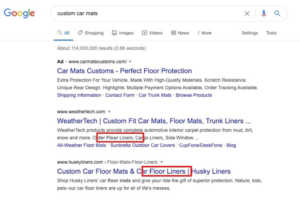What are your customers searching for? The words and phrases they use (aka your “keywords”) should be peppered throughout your website so that search engines know to direct your customers to you. This is a key part of any search engine optimization (SEO) strategy.
But beware! Google can tell if you’re artificially cramming in these words for the sake of it, and they penalize sites that do. For effective SEO, you need to make sure that your keywords seamlessly blend into your content so that they’re readable and relevant to your customers.
How to use keywords for search engine optimization
- Use keywords sparingly
- Synonyms count in SEO!
- Position them effectively
- Write on topics that naturally include your keyword
“Do you need custom car mats? The best thing about custom car mats is that custom car mats are custom made to fit your car.”
Yuck! Keyword stuffing is extremely unpleasant to read. It’s unnatural and not at all user friendly. Your readers will be off your page before you can say “who the heck buys custom car mats?” The practice dates back to the early 00s and it’s disturbing to see it still in use today.
In the days of yore, search engines relied on exact search matches. Knowing this, dodgy SEO companies shoved as many keywords in their websites as possible. But Google et al quickly cottoned on to what was happening and changed their algorithms to penalize websites that implement this ugly practice.
Nowadays the ideal keyword density is 0.5 – 3%. That means that in a 600-word article, your target phrase can appear 3 – 18 times. After writing a piece of content, search all the instances you use the keyword and assess whether there are too many and whether they are too closely positioned in your text. This brings us neatly onto our next point…
If you find yourself repetitively using your keyword, substitute with some synonyms. It not only makes your writing more enjoyable and easier to read, but Google also recognizes synonyms. Take our “custom car mat” example.

As you can see, Google also recognizes “floor liners” as a matching search term. The words don’t even have to be in the same order, they just need to be in the same sentence.
Less is more when it comes to using keywords naturally. But it also means you have less to work with. Make sure you maximize the effectiveness of your keywords by positioning them strategically throughout your writing. Your word or phrase should appear in the title (H1) and the opening paragraph of your article, and then a few times in the main body of your text (bonus points if you can include it in your H2). As we mentioned, the ideal density is between 0.5 – 3% of your text. That should be fairly easy to accomplish.
We highly recommend the Yoast SEO WordPress plugin. It checks how often keywords appear in your writing and whether they are well-positioned. It also gives you other tips and pointers on improving search engine optimization on every page of your website. The free version is fairly good, although it only checks exact keyphrase matches and it doesn’t pick up on synonyms.
By far the best way to include your keyword naturally is to write about relevant and related topics. Shoehorning an unrelated phrase into your content is possible, but it’s very hard to do it naturally and elegantly. If you’re not sure about what to write, research to find out what questions people are asking related to your keyphrase, and dedicate an article to answer each question. That way it will be relevant to your customers, and will naturally include your keyword.
Search engine optimization is one of those buzzwords that every online business owner has heard of, but might not know exactly what it entails. There’s a lot of false or misguided information out there about SEO and plenty of companies who promise to get you ranking first on Google for your favorite search term. In the world of SEO, if you think something sounds too good to be true, you’re almost definitely right. Small and mid-sized businesses that don’t have an inordinate amount of money to budget on SEO can still benefit, but the strategies entailed are different.
At jdp, we don’t blanket-subscribe any one online marketing solution. Each business is different and requires different maintenance and different strategies. We assess your business to discover which strategy would be of most value. We aim to increase traffic and opportunities for you to connect with your audience and increase sales. That might include SEO, or it might not.
Cut out the guesswork on what’s the best next step for your business and get in touch with us.





